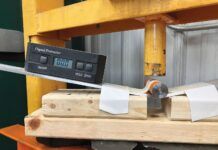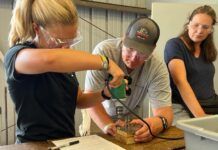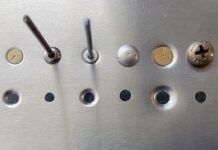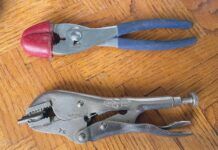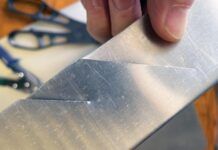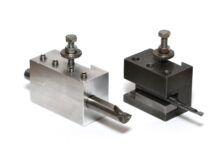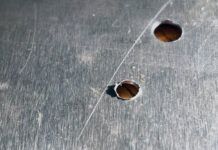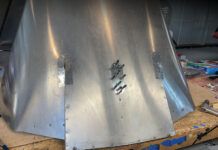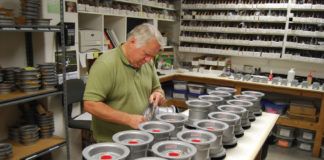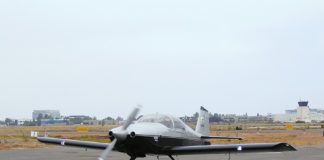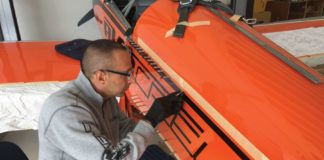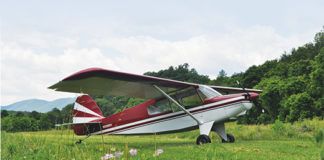When the editor first set me this assignment of investigating techniques for polishing aluminum I thought, “Oh great! Heres where Im going to get arms akin to the first day of boot camp: Gimme 20, Fritz!” I was not entirely enthusiastic about it, but my wife has wanted to have a polished spinner on her Cessna 172, so I thought it would be two birds with one stone. (Besides, what Li wants, Li gets.)
Step one was the research. Checking with aviation museums and the Airstream trailer crowd seemed a good first stop. After all, what groups are more obsessed with polishing aluminum than these two? I found two buffing compounds recommended, but mutual agreement on the buffing technique. So as not to imply “camps,” I should point out that the division of opinion had nothing to do with the products being polished. That is, Airstreamers were split, as were the museums.
Whats Available?
Lets look at the polishing compounds first. One group extolled the virtues of the PDQ series of products from Alcoa. The worlds largest manufacturer of aluminum must know something about it, so it seemed a plausible point of view. However, I found that only about 20% of those surveyed were championing PDQ. The other 80% raised their banners for a multi-step process using a product out of New York called Nuvite. These users were equally positive that they had found, if not the Holy Grail, at least the polish to be used when it does surface.
The other area, the one on which the experts agree, was how to apply the polishing compound. The consensus was that muscle is for polishing nothing larger than your Aunt Lavidas silver tea set. In short, they soundly rejected the rag-and-rub technique as being so laborious that only a caveman would do it.
This was encouraging news. Ive learned that there are three ways to get something done: Do it yourself, hire someone or forbid your kids to do it. I cant afford the second option, and the kids are grown and gone, leaving me, caveman with rag in hand, looking for a way out. I thought of temporarily adopting the neighbors kids, but remembered O. Henrys story “The Ransom of Red Chief,” and realized that they may have a no-return policy.
Exactly what to use for muscle was uncontested. Start with an 8-inch buffing pad, spinning not more than 500 rpm on either a 90 drill motor or s 90 grinder from Harbor Freight. Cordless drills will overheat, but give it a shot if you must. What you do not want is high rpm. A tour of the auto parts stores revealed choices ranging from inadequate to absurd. Too low or too high an rpm (one advertised itself as “fastest in the industry…4000 rpm”) was the norm. This is clearly not the place to find the mechanical aids that will put the finishing touch on your years of labor.
For that final, mirror-like finish, it was unanimously agreed that the winner in this arena is the Cyclo 5 polisher from Cyclo Tool Makers. This is a two-head polisher that orbits each pad much as your hands would move. While the Cyclo itself retails for $275, the whole kit including rags, fuzzy buffers, and microfiber towels will boost the price to about $400. But given the amount of money you’ve put in, and the amount of work you want to avoid, that seems if not a pittance at least certifiably reasonable.
People Will Talk
Right now someone is saying, “Why not use a random-orbital sander?” Several owners of polished aircraft named Tom Numelin of Perfect Polish as being the guru of gleam. He answered that question by pointing out that a random-orbital sander moves only about 1/16-inch, which is fine for rigid sandpaper on flat wood. However, you’re working on a curved surface with a couple thousand rivets and several feet of overlapping aluminum edges, so you’ll want to use foam pads to conform to the height changes. If the pads are soft enough to conform, theyll simply absorb that 1/16-inch of motion. The Cyclo, however, moves in 5/8-inch orbits that will transmit to the working surface.
Research completed, Numelin set up a demonstration of the Nuvite system. (A very detailed how-to is listed on the web site, so I wont go into it here.) To apply the first of several compounds, imagine that you’re being fingerprinted. Use just enough compound to leave fingerprints every 6 to 8 inches over a 24-inch square area. Hold the pad at about 30, apply enough pressure to flex the pad, and pull toward yourself in a straight line at a rate of about 1 inch per second. Remember to keep the speed down to about 400-500 rpm. Even that speed can generate enough heat to cause the metal to oil-can several times; imagine what that 4000-rpm machine would do. The point was made repeatedly that most beginners go wrong by putting too much compound on the metal. That results in the pad simply floating above the metal and throwing splatter all over the shop. Keep thinking fingerprinting.
When you finish a pass of about 24 inches, move over and do it again. Step and repeat this within a 24-inch square until the black residue is gone. Now look closely at the area, and you’ll likely see a grain pattern in the aluminum. For some, thats good enough. But if you want to count the stitches on your shirt in the reflection you’ll need to repeat this a couple of times with finer compounds. And be diligent about removing old compound between passes. Mineral oil and a microfiber cloth are best. Do not use cotton, as it scratches, and do not use anything with ammonia, as it reacts with the aluminum. Numelin emphasized that only small dabs are needed, and as you get closer to the perfect finish, you’ll use even less compound.
Standing there, amazed at the shine, prompted another thought: Can the shine be kept by coating it with wax or some other magic product? After all, why should anyone other than a masochist want to spend an inordinate amount of time polishing? Jack Nicholson as the dental patient in the original version of The Little Shop of Horrors springs to mind: “Dont you think you could at least pull one tooth?”
When the Nuvite factory was asked about protective coatings, the recommendation was, “Use nothing.” There are two reasons for this. Consider that you just worked like crazy to get a slick surface. If you were going to paint it, youd be roughing it up to get the paint to stick, so it hardly makes sense to expect a coating to bond to a surface that was intentionally made smooth. That means that when part of the top coat comes loose, as it eventually will, its going to look different than the adjacent area. In turn, that means that you have to remove the remainder of the top coat, which will entail damaging the aluminum. Go to jail. Do not pass Go.
The second reason is closely related to the first. You’ve seen those super-brilliant Airstream trailers. The older ones had nothing applied, but with time and customer demand, the factory shifted to coating. The Airstream cognoscenti claim they can spot a newer trailer, because the coating eventually gets cloudy and it just doesn’t shine the way the older ones do.
Post-Polish Maintenance
Must you anticipate more polishing than flying? Actually, no. It seems that every time you polish your plane, you extend the time between polishings. The oxides have depth, which means that you wont get 100% of the oxide off in the first spate of polishing, and the residue will act as a “seed” for new corrosion. But each successive polishing will get you closer to the magic 100%, thereby extending the period between polishings. Its reported that aircraft and Airstreams that have been kept up need a light going-over only once a year.
Of course, while Numelin made no bones about getting that first good shine (“Its a lot of work…an RV-7 should take about 100 hours”), it should also be pointed out that a paint job can cost $5000-$10,000 and will also have to be waxed annually. He also explained that different aluminums respond to the process in different ways. For instance, the Sonex and Murphy Rebel use 6061 T6, which makes them hard to polish but they hold the shine. An RV, on the other hand, is Alclad, which is easier to polish but needs touching up more frequently.
Numelin also suggested that if you’re in the building stage, polish the material while its on the workbench, and then touch up after assembly. This is not only an easier position for you, the material is fully supported so you can bear down on it in a way you dare not when polishing the area between wingribs. A tip: Numelins Swift is not only kept in a hangar, its covered with soft cloths to keep bird poop, dust and condensation at a distance. “Paint the wings and the bottom of the fuselage,” he says. “Polish the rest.”
You were probably hoping that a definitive answer was forthcoming, but so far all you’ve read is “Yes, but…” Well, thats just the way it is. Ford versus Chevy. Paint gun or buffer, you takes your pick and you gets what you got. In all honesty, though, you’ll be amazed and hugely encouraged by the results of that first pass with the 8-inch buffer. It gets you to the 90% point on the first try. The last 10% will take four to six more passes with finer compounds.
Does it damage paint? A close look at Numelins Swift revealed that the blue stripes were essentially untouched by the final-finish process. I found only one rivet that showed a bit of aluminum where it shouldn’t, and Numelin polishes his plane far more frequently than most. One word of caution: Numelin emphasized that the coarse grades of Nuvite can damage paint, but the finish grade with the Cyclo polisher is safe to use around paint.
The Basis of Comparison
Unfortunately, I was unable to put my hands on a sample of the PDQ products. Alcoa didn’t return phone calls, so a direct comparison remains to be done. Perhaps if someone at the HQ reads this, theyll get in touch and we can give it a shot.
One final comparison was doable, however. A tour of the auto parts store shelves revealed a half dozen bottles of magic potions for aluminum. With one exception, they were all about the same price and, naively expecting that higher price meant better product, I chose the expensive compound marketed under the name of Mothers for comparison. With a fresh pad on the rotating buffer and a new cloth on the Cyclo, I attacked another piece of aluminum.
Like the previous test, most of the gain was in the first pass. However, several passes failed to yield even an approximation of the depth of shine achieved with Nuvite. The grain in the aluminum was present after several passes, and where the black residue was mostly removed by the Nuvite process, it had to be manually wiped off with solvent when working with Mothers.
So am I going to paint my RV-6 or polish it? Ill let you know. Maybe both. First, though, I have to do that spinner on my wifes 172.


